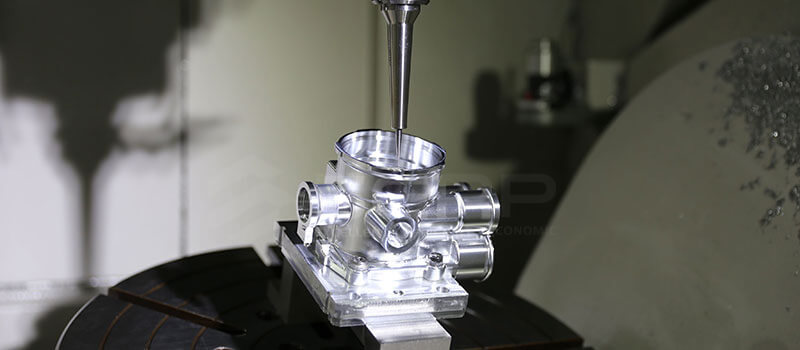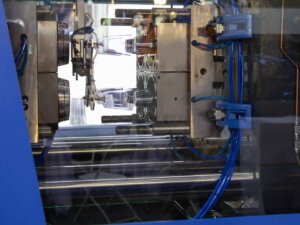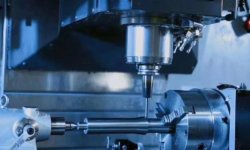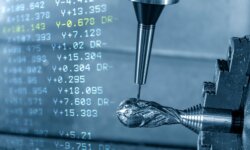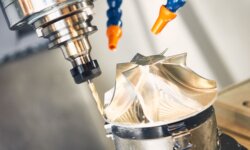With the rise of intricate, small-scale parts, manufacturing evolves daily, now heavily relying on advanced techniques like 5-axis CNC machining. Traditional methods often fail to meet these complex demands, leading industry professionals to adopt these sophisticated processes.
Any multi-axis CNC method, such as the 5-axis machining, brings in a whole new dimension of capabilities and what can be produced. However, being a new technology for professionals, they often wonder about the basics of this process, such as what it is, its working process, what are the different types of 5-axis CNC machining options, its application, and many questions.
This article will go through all this information, and more. With the information present here, you will also learn how to optimize your CNC machining process and reach new heights in terms of productivity and quality of parts.
What is 5-Axis Machining?
5-axis machining is a multiaxis machining process where the machine’s capabilities are present in five different axes. The cutting tool of the machine has five different freedom of movement, which allows it to create a highly complex geometry.
To further understand the concept of 5-axis machining, it is necessary to understand what ‘Axis’ means in CNC machining.
CNC stands for Computer Numerical Control, and in machining, it denotes computerized control over the movement of the cutting tool. ‘Axis’ refers to the freedom of movement of the cutting tool, i.e. the direction in which the cutting tool is capable of movement.
History of 5-Axis Machining
While modern-day 5-axis machining is entirely based on Computer Numerical Control technology, its early development happened independently, even before CNC technology was developed for the masses.
This occurred in 1958 when Cincinnati Milling Machine Co. (now Milacron) worked on a US Air Force project of a 5-axis vertical milling machine.
Despite this early electronic tracing model, it took until the late 1990s for modern 5-axis machines to be available for mass usage due to the relatively slow progress of numerical control, software, and other required technologies.
What are the Different Axes in 5-axis Machining?
To understand the fundamentals of 5-axis machining, it is important to understand how the cutting tool moves in the various axes in this technology. As mentioned earlier, the 5-axis denotes the number of freedom of movement in which the cutting tool can move. Every axis is denoted by a letter for the purpose of simplicity and standardization.
Additionally, another important point to remember is that a 4-axis machine contains all the axes of a 3-axis machine along with an additional axis, and a 5-axis machine contains all the axes of a 3-axis machine along with two additional fourth and fifth axes.
Here are the different axis present in 5-axis CNC machining:
- X-axis: Movement of left to right
- Y-axis: Movement of top to bottom (or up and down)
- Z-axis: Movement of front to back (or in and out)
- A-axis: Rotary axis, rotation around the X-axis
- B-axis: Rotary axis, rotation around the Y-axis
- Sometimes, a third rotary axis, called the C axis (rotating along the Z-axis) is present, replacing either the A-axis or the B-axis.
In 3-axis machining, only X, Y, and Z axis are present. 5-axis machining contains these three axes along with two additional rotary axes.
Types of 5-axis CNC Machining
There are many variations of the 5-axis CNC machining process. The usage of any particular type depends on the final part geometry required and the performance characteristics desired.
Simultaneous 5-axis CNC Machining
Simultaneous 5-axis CNC machining is also called continuous 5-axis CNC machining. When the generic ‘5-axis CNC machining’ term is used, this is the technology it refers to. In this process, the cutting tools are capable of moving in all five axes simultaneously.
3+2 Machining
The 3+2 machining process is also known as positional 5-axis machining or indexed 5-axis machining. In this method, the cutting tool is locked in a tilted position in the A and B axis, and then the 3-axis CNC machining is carried out in the X, Y, and Z axis.
The advantages of this process are that:
- a.) it allows for the use of shorter cutting tools. Shorter cutting tools lead to faster cutting and low deflection during the machining process.
- b.) it allows the machining of deep cavities and other intricate features that would not be possible with conventional 3-axis machining.
Different Between 5-axis CNC Machining and 3+2 Machining
5-axis CNC Machining should not be confused with 3+2 machining as the capabilities of these two technologies vary significantly. While 3+2 machining has a locked cutting tool in the A and B axes, 5-axis machining involves the movement of the cutting tool in all five axes simultaneously.
Therefore, 5-axis CNC machining is able to do everything that a 3+2 machine can, but the vice versa is not true. There are many complex contour surfaces that can only be created with 5-axis CNC machining and 3+2 machining just won’t do. However, 3+2 machining can be used for plane processing, for a faster manufacturing process.
4+1 Machining
4+1 machining is another variation of 5-axis machining which locks one rotary axis while allowing movement in the 3 linear axes (X, Y, and Z) and any single rotary axis.
It provides a middle way between 3+2 machining and simultaneous 5-axis machining.
However, its application is not as popular as these other two methods. For the machining of complex geometry, simultaneous 5-axis CNC machining will produce parts of superior quality.
Mill-Turn 5-axis CNC Machining
Mill-turn CNC machining provides increased efficiency and capability to the simultaneous 5-axis machines. In these machines, besides the 5-axis movements of the cutting tool, the block itself has the feature to rotate (similar to turning).
Different Forms of 5-axis CNC Machines
There are different forms of 5-axis CNC machines, such as:
Rotary Table With Pivoting Spindle Head Configuration
These types of CNC machines have a rotary table under the workpiece, which rotates in the B axis. The table is capable of 360-degree movements. The spindle itself is pivoted on the A-axis, capable of movements up to certain degrees.
Double Rotary Table Configuration
A double rotary table form is present in the horizontal machining center configuration. The first rotary axis is the B axis on the rotary table. The second rotary axis is mounted as the A-axis on the main table. There are multiple setups involving the positioning of the A-axis on the table. Since the programmer has to know a fixed position, the A-axis is assumed on a particular point on the table. During machining, the operator then does the setup for positioning the A-axis according to the programmer’s instructions.
Trunnion Style Configuration
A trunnion-style machine is also termed as a table/table configuration. This is because the rotary axes of the machine are present in the trunnion table itself. It is an easy configuration from the perspective of programming for the part and the operation of the machine.
Double Pivot Spindle Head Configuration
Swivel head configuration is also known as articulating head configuration, double swivel head form, or head/head configuration. In the head/head setup, both rotary axes are present in the head itself. The workpiece is held stationary, allowing for a more stable work surface and the creation of heavier parts. Large parts can be made with this method. However, movement is limited in the rotary axes, placing some restrictions when it comes to complex parts.
Advantages of 5-axis Machining
5-axis CNC machining finds itself in popular practice, due to the several benefits it has to offer. Some of the benefits of 5-axis machining are:
- Complex Designs: The ability to create complex parts is the reason that 5-axis machining is used over 3-axis or 4-axis options. These machines can create parts that traditional manufacturing methods took many machine tools to recreate.
- Setup: Since this process works in five axes, multiple surfaces of the workpiece can be machined simultaneously, without altering the setup. This reduces the machining time since multiple setups are not required and most parts can be created in one setup.
- Accuracy: 5-axis machining can provide very high precision. This is mainly because of the fact that for these machines, manufacturing is a one-time process. When a part is removed and realigned, it alters the positioning slightly, lowering the precision. However, a single setup operation requires no part realignment, leading to high precision.
- High Productivity: The high-speed operation coupled with high accuracy means that the productivity of the entire process is increased. This makes 5-axis machining a very efficient manufacturing process.
- Better Surface Finish: Since the cutting tool is capable of rotation, shorter cutting tools can be used. This not only increases the precision but also improves the surface finishes of the workpiece. This is because of the reduced vibration of the cutting tool.
- Reduced Labor Cost: Due to faster operation and lack of multiple setups, the labor cost and requirement for the whole process are reduced.
Disadvantages of 5-axis Machining
5-axis machining is a vastly successful CNC process. Some disadvantages that professionals can find are:
- Costs: Investing in a 5-axis CNC machine is not a cheap affair. These machines can demand a high initial cost, along with skilled operators. However, a good way to avoid these high initial costs is to get a 5-axis machining service provider such as 3ERP.
- Programming: Creating the programs for 5-axis CNC machining is not as easy as lower-axis machines.
Applications of 5-axis CNC Machining
There are many use cases of 5-axis CNC machining, such as:
- Aerospace Industry: Aerospace industry constantly requires niche and complex parts at every stage, from prototyping to production. Only multi-axis CNC machining technologies like the 5-axis are able to fulfill these requirements.
- Medical Industry: Industries in the healthcare sector heavily rely on the 5-axis CNC machining process. These machines are used to create medical devices, implants, prosthetics, and many other medical products.
- Automobile Industry: In the automotive industry, 5-axis CNC technology allows the creation of complex geometries such as gearbox, drive axle, engine components, and more. It can also create custom parts required by automotive workshops.
- Military: Multi-axis CNC machines are the backbone of innovation in the military and defense industries. This technology can create everything from parts of small weapons to large submarines and aircraft components.
There are many other applications of 5-axis CNC machines. The vast usage of this technology is mainly because of the large number of materials that it can process. Some of the common materials that undergo this machining technology are:
- Titanium
- Inconel
- Steel (all grades)
- Stainless Steel
- Aluminum (all grades)
- Brass
- Copper
- Wood
- Foam
- Fiberglass
- Plastics
Tips For Improving the 5-axis Machining Performance
A 5-axis CNC machine on its own is a marvelous technology. Even so, there are certain steps that you can take to improve the quality of the parts and the performance of the machine even further.
1. Simulations: Most CAD software offer simulations for running a virtual mockup execution of the part program. The simulation helps in identifying any possible errors that can come up during the machining of the part, or errors in the program. Before sending the program to the machine for execution, do use these simulations beforehand.
2. Correct Tooling: Utilize tools that are designed for 5-axis CNC machining and support your particular equipment. The loading and unloading should be effortless. Ideally, the finished product should come off without using any physical force.
3. Understand the Machine: Before investing in the machine, understand your requirements and the capabilities of 5-axis CNC machining technology. After that, you can accurately judge whether or not 5-axis CNC machining is something you require. This helps in saving money for many people.
4. Better Programming: 5-axis machining is capable of a higher degree of movement, so it can create the final part in lesser passes. For this purpose, it is important to create optimized programs. Hire skilled programmers for this purpose.
Is 5-axis Machining the Right Fit For Your Business?
5-axis machining can improve the yield for any business. Not only does it increase production efficiency, it also provides high-quality surface finishes to the parts. Additionally, while the initial costs are high, the operational costs are actually lower due to the reduced labor costs.$50
What is the Cost of a 5-axis CNC Machine?
The cost of a 5-axis CNC machine lies in a wide price bracket, mainly depending on the capability of the machine. Entry-level models can start at $200,000 and range up to $500,000. For production-level 5-axis CNC machines, the price will go upward of $500,000.
Obviously, the price of the machine alone can be intimidating, let alone the added costs of tooling and other expenditure. For this purpose, most businesses prefer to use 3ERP’s manufacturing services.
3ERP houses industry-leading multi-axis CNC machines, including the 5-axis machines. The benefit of outsourcing your manufacturing requirement to 3ERP is that you can use the capability of these machines without paying the high initial costs associated with the same.
Prototyping specialist 3ERP is one of the leading CNC machining companies, and one of a select number that can offer 5-axis machining services in addition to the more common 3-axis variety. Our HAAS CNC milling services are some of the best available, and the company’s engineers have many years of experience in the field. 3ERP also offers a wide range of materials, including plastics like ABS, Teflon and PEEK, and metals like Aluminum, Steel and Titanium.
Speak to 3ERP about your CNC machining needs to find out whether 4-axis or 5-axis machining could present the best solution for your project.
Catering to every requirement from rapid prototyping to mass production, you just have to upload your CAD designs and 3ERP takes care of the rest.
Conclusion
5-axis machining is definitely one of the go-to technologies in modern manufacturing. There are countless benefits like faster production, reduced setup time, the possibility of making complex parts, and higher precision. The only drawback is the high initial investment, which can also be eliminated by outsourcing your manufacturing to experts like 3ERP.
Frequently Asked Questions
Here are the answers to some common questions regarding 5-axis CNC machining:
1. What is the difference between 3-axis and 5-axis CNC machining?
3-axis machining allows the cutting tool movement in three linear axes, i.e. the X, Y, and Z axes. 5-axis machines contain an additional two rotational axes, the A-axis (rotating around X-axis) and the B-axis (rotating around Y-axis). In some forms, there is a C-axis that replaces either the A-axis or the B-axis.
2. What is the difference between 3, 4, and 5-axis CNC machining?
3, 4, and 5-axis CNC machines differ in the number of directions in which the cutting tool can move. 3-axis machining allows for only linear movement of the cutting head in the X, Y, and Z axes. 4-axis machining utilizes one additional rotary axis. Similarly, 5-axis CNC machining adds two rotational axes in addition to the three linear axes.
